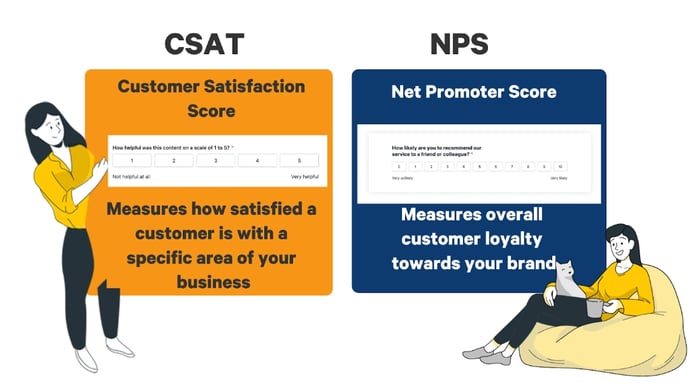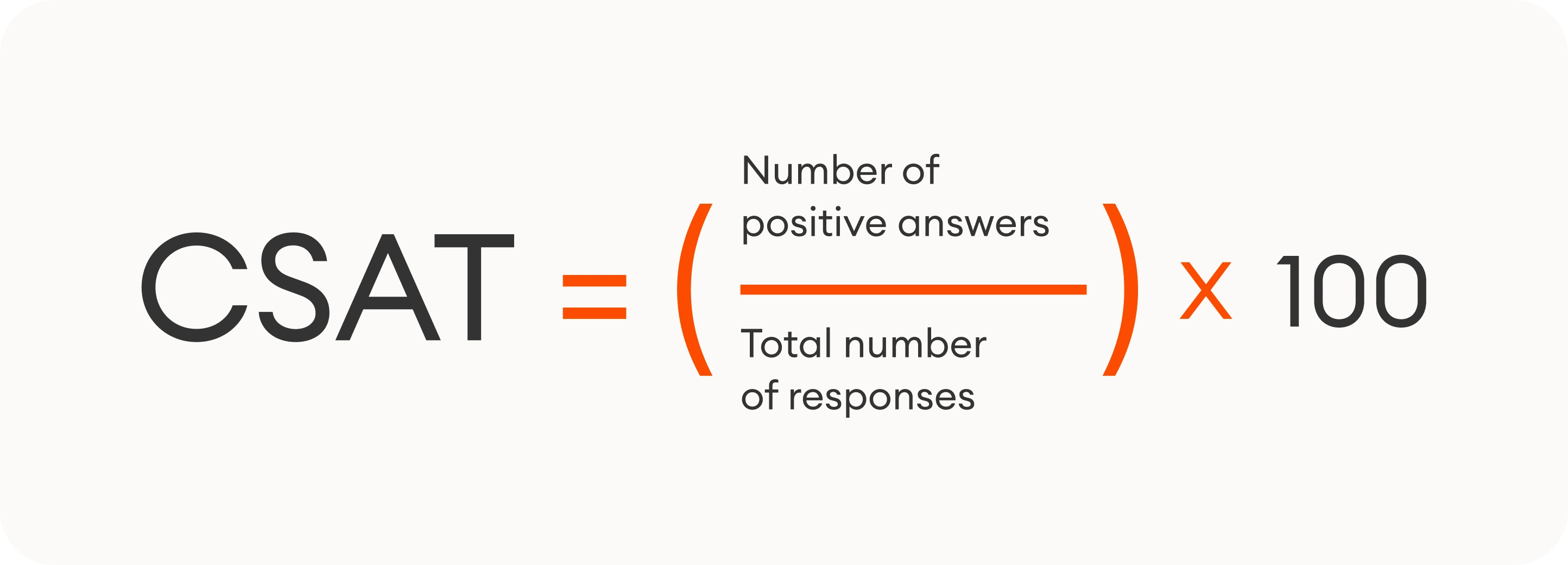Net Promoter Score Vs Customer Satisfaction Score: Full Comparison
Success in the ever-changing world of e-commerce depends critically on recognizing and evaluating client satisfaction. Let me introduce you to two commonly used metrics: Customer Satisfaction Score (CSAT) and Net Promoter Score (NPS).
NPS, which was first presented by Fred Reichheld, and CSAT, a reliable indicator of customer satisfaction, act as benchmarks that help companies achieve their dual objectives of retaining customers and building a favorable brand image.
When companies aim to establish enduring relationships with their customers, the combination of NPS and CSAT turns into a powerful tool for monitoring customer satisfaction and guiding them toward continuous development in the quest for unmatched customer-centricity.
In this article, I will briefly what the Net Promoter Score and Customer Satisfaction Score are, the aspects of comparisons between them, and why both of these metrics should be used for e-commerce businesses.
Table of contents:
- What are net promoter score and customer satisfaction score?
- What are the Key differences between them?
- NPS calculation Formula
- How To Calculate CSAT?
- Four Techniques To Improve Your NPS and CSAT
- Why should both of them be used for e-commerce businesses?
Net Promoter Score Vs Customer Satisfaction Score: The Definition
Net Promoter Score (NPS) is used to assess how satisfied and loyal a customer is. To clarify more, "How likely is it that you would recommend our company/product/service to a friend or colleague?" is the only question that determines the NPS. Usually, respondents give their response on a scale of 0 to 10, where 0 represents "Not at all likely" and 10 represents "Extremely likely."
Customer Satisfaction Score (CSAT) is a widely used metric that shows how happy consumers are with the goods or services provided by a business. Customer feedback is used to measure it, and the result is expressed as a percentage (100% would be great – 0% would be awful).
The Key Difference Between NPS and CSAT
 Image source: trustmary.com
Image source: trustmary.com
The two customer experience metrics differ primarily in how they characterize different aspects of the consumer experience. While NPS is more suited to gauge an organization's overall customer connection, CSAT gauges consumer satisfaction with a specific product or service.
Therefore, NPS can measure your customers' feelings about your brand over a longer period, while CSAT typically describes how they feel about a recent purchase or sale.
Alternatively, one is more relational (NPS) and the other more transactional (CSAT). Find out more about relational versus transactional feedback.
Net Promoter Score Vs Customer Satisfaction Score: How To Calculate?
NPS calculation Formula
NPS Score formula is quite basic and asks users to respond to a single, multiple-choice question. This is how it usually is: To what extent would you suggest our Brand to a friend or colleague?
This time, the answers are ranked from 0 to 10, where 0 represents "extremely unlikely" and 10 represents "extremely likely." Following that, those answers are divided into three groups:
- Promoters (with a score of 9 or 10): These consumers are the most devoted to your brand; they are the ones who will tell others about it.
- Passives (with a score of 7 or 8): These clients are susceptible to being persuaded by compelling offers because they don't feel strongly about you in any direction.
- Disagreements (0–6): These clients had a negative experience, and by advising others to avoid you, they can intentionally harm your reputation.
You can determine your ultimate Net Promoter Score by deducting the percentage of critics from the percentage of supporters. Your NPS would be 70-20, or 50 if 20% of responders are critics, 10% are passives, and 70% are promoters.
How To Calculate CSAT?

By using customer satisfaction surveys to gather responses to one straightforward question, "How would you rate your overall satisfaction with the [goods/service] you received?" one may determine a dependable customer satisfaction statistic.
The consistency of the response is crucial, even when the question's specific wording may vary: Every CSAT poll has a 1–5 rating system:
- Very dissatisfied
- Not happy
- Indifferent Content
- Incredibly happy
And those final two—satisfied or very satisfied—are what we want to concentrate on when calculating customer satisfaction. This is because the two feedback survey values with the best accuracy are those that indicate client retention.
All that's left to do is convert those happy clients into a percentage of all responders. To accomplish that, simply divide the total number of survey replies by the number of satisfied customers (4 and 5 responses), then multiply the result by 100. Your CSAT score will then be determined by calculating the percentage of pleased customers.
Four Techniques To Improve Your NPS and CSAT

Once you get your scores from each metric, you have to take action and focus on your next step. You better set yourself goals to reach from these attained scores. Here is what you can do!:
- Focus on improving interactions with your customers
The success of your business greatly depends on the way you communicate with your existing and new clients. When it comes to winning over new and existing consumers, you risk making even more mistakes that will ultimately cost you a lot of money and a loss of loyal clients. Instead, pay attention to what they have to say.
- Highlight aspects of issues
As an online business owner, let's face it: receiving unfavorable comments usually stings a little. However, it's essential if you want to enhance and grow your company. Your CSAT and NPS can help you understand typical issues or complaints, how to enhance your offering, and how your company is performing overall.
- Decrease Customer Dropout
Let's be honest, Receiving unfavorable criticism hurts a little when you own a business. However, if you want to advance and strengthen your company, this is a must. Your company's overall performance as well as regular issues or complaints, as well as methods to enhance your offering, can all be learned from your CSAT and NPS.
Thus, pay particular attention to the negatives when reviewing your scores. This allows you to monitor your company's performance and make adjustments along the route to raise client satisfaction and metrics.
- Drive Positive Customer review
Your customer satisfaction measurements are useful for more than just identifying issues and making people smile. Additionally, you can use the positive feedback provided by NPS and CSAT to ask satisfied clients to promote your company positively. Don't forget to take advantage of compliments as well. Sort through your favorable evaluations.
Which metric serves better?
As a marketer, you might ask which metric serves better. You usually want to use the most efficient metric with the most accurate responses. Customer satisfaction ratings and Net Promoter Score (NPS) are not considered to be the "better" metrics because they have different uses.
A customer satisfaction score is frequently a useful metric for identifying doable, quick fixes that can improve the customer experience. NPS, on the other hand, provides a more comprehensive, long-term picture of your business.
So my advice to you is that you will need to prioritize according to your objectives if you truly only have the resources to concentrate on one.
To reach the maximum benefit, as you can see, two measures are far from equivalent even though they both reflect consumer sentiment: CSAT and NPS. To get the most out of both, CSAT and NPS should be used wisely since they complement one another. Which is better or worse doesn't matter. It has to do with how properly utilizing them can improve the experience of your clients.
To improve your customer experience overall, you must employ NPS and CSAT in tandem. No "better" metric exists.
Why do e-commerce Companies Use both NPS and CSAT?
1- Strategic Improvement Focus
CSAT is beneficial for identifying immediate areas of improvement based on transactional feedback, while NPS can guide strategic, long-term improvements to enhance overall customer loyalty and advocacy.
2- Various Viewpoints
NPS: Examines the relationship and loyalty in its entirety and aids in determining the e-commerce brand's long-term viability.
CSAT: Offers information about the current level of customer satisfaction with a recent transaction, exchange, or particular step in the customer journey.
3- Practical Takeaways
NPS: Helps you focus on converting passives into promoters and enhancing the overall customer experience by identifying promoters, detractors, and passives.
CSAT: Helps you address particular pain points in the customer journey by highlighting areas that require immediate attention or improvement.
4- Strategic versus Tactic
NPS: Provides a long-term, strategic viewpoint on consumer loyalty and brand perception.
CSAT: Assists in quick fixes and enhancements by offering tactical insights into specific transactions or touchpoints.
5- Benchmarking
NPS: This comparative indicator of customer loyalty can be used to benchmark against competitors or industry norms.
CSAT: Makes it possible to compare particular elements of the customer experience to industry norms.
6- Retention of Customers
Because advocates are more likely to stick with a brand and keep making purchases, net promoter score (NPS) can be used to predict customer growth and retention.
CSAT: Offers information about what influences instant satisfaction, which helps with transactional customer retention.
Please take note: to get the most out of both, CSAT and NPS should be used wisely since they complement one another. Which is better or worse doesn't matter. It has to do with how properly utilizing them can improve the experience of your clients
 By
By


